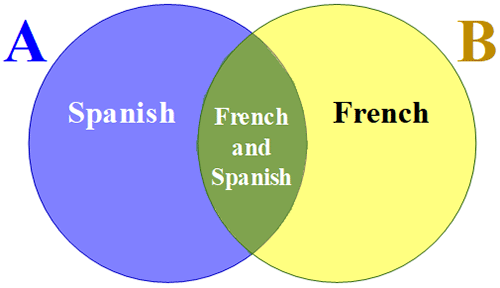Learn
Compound Inequalities
Compound inequalities are like taking classes. Some people take French and Spanish, some people take French or Spanish, and some people take neither. Look at the diagram below:

The students in blue Side A only take Spanish and the students in yellow Side B only take French. The students in the green area in the middle (overlapping yellow and blue) take both classes. The white areas outside Sides A and B don't take either course. Compound inequalities are what happens when we are dealing with more than one situation.
What are Compound Inequalities?
A compound inequality is two simple inequalities joined by and or or.
A number is a solution of a compound inequality with or if the number is a solution of at least one of the inequalities.
A number is a solution of a compound inequality with and if the number is a solution of both inequalities.
Example #1
Let us start with writing and graphing a compound inequality.
Open Solve and Graph an "and" Inequality Example #1 in a new tab
Example #2
Open Solve and Graph Compound Inequalities in One Variable Example #2 in a new tab
Example #3
Open Solve and Graph an "or" Inequality Example #3 in a new tab
Intersections and Unions
Compound inequalities either form an intersection or a union.
An intersection (∩) occurs where two things overlap.
For example, if we take two different colors and mix parts of them together, we will get a new color. Yellow and blue are different colors, but when you mix them you get green (like the Venn diagram from earlier).

In inequalities, an intersection is the solution to a compound inequality that uses the word "and".
A union (∪) occurs when we put things together to get a larger group. For example, the United States of America is a bunch of individual states that don't overlap, but, when put together, they form a union.

In inequalities, a union is the solution to a compound inequality that uses the word "or".